Embioptera
| Embioptera Temporal range: 199–0 Ma Jurassic – Recent | |
|---|---|
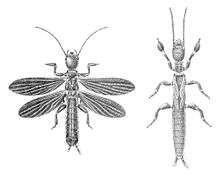 | |
| Scientific classification | |
| Kingdom: | Animalia |
| Phylum: | Arthropoda |
| Class: | Insecta |
| Subclass: | Pterygota |
| Infraclass: | Neoptera |
| Order: | Embioptera Lameere, 1900 |
| Families | |
|
There are 2 suborders and 10 families:
| |
The order Embioptera, commonly known as webspinners, are a small group of mostly tropical and subtropical insects, classified under the subclass Pterygota. The order has also been referred to as Embiodea or Embiidina.[1] The name Embioptera ("lively wings") comes from Greek, εμβιος, embios meaning "lively" and πτερον, pteron meaning "wing", a name that has not been considered to be particularly descriptive for this group of fliers,[2] perhaps instead referring to their remarkable speed of movement both forward and backward.[3] The group probably first appeared during the Jurassic and is well represented in Cretaceous amber. The common name webspinner comes from the insects' unique ability to spin silk from structures on their front legs. They use the silk to make a web-like pouch or gallery in which they live.
Over 360 embiopteran species have been described,[2][4] along with estimates of around 2000 species being in existence today.[5] There is some debate as to the exact phylogenetic classification of Embioptera, with the order having been classed as a sister group to both orders Zoraptera,[2][6] and Phasmatodea,[7] and there is continuing dispute today concerning the accuracy of these classifications.[8]
The order is distributed all over the world, being found on every continent except Antarctica, with the highest density and diversity of species being located in tropical regions.[9]
Description
All webspinners have a remarkably similar body form, although they do vary in colouration and size. The majority are brown or black in colour, ranging through to a pink or reddish shades in some species, and range in size from 15 to 20 millimetres (0.59 to 0.79 in). The body form of these insects is completely specialised for the silk tunnels and chambers in which they reside, being long, narrow and highly flexible.[10] All the females and nymphs are wingless, whereas adult males can be either winged or wingless depending on species. .[9] The head has projecting mouthparts with chewing mandibles. The compound eyes are kidney-shaped, there are no ocelli, and the antennae are long, with up to 32 segments.[11]
The body is cylindrical in form, adapted for the tubular galleries within which the insects live. The first segment of the thorax is small and narrow, while the second and third are larger and broader, especially in the males, where they include the flight muscles. The wings, where present, occur as 2 pairs that are similar in size and shape: long and narrow, with relatively simple venation. These wings operate using basic hydraulics; pre-flight, chambers within the wings fill with hemolymph, making them rigid enough for use. On landing these chambers empty and wings become flexible, folding back against the body. Wings can also fold forwards over the body, and this, along with the flexibility allows easy movement through the narrow silk galleries without resulting in damage.[9]
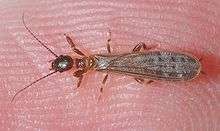
In both males and females the legs are short and sturdy, with an enlarged tarsomere on the first pair, containing the silk-producing glands.[12] The abdomen has ten segments, with a pair of cerci on the final segment. These cerci are highly sensitive to touch, and allow the animal to navigate while moving backwards through the gallery tunnels, which are too narrow to allow the insect to turn round.[11] Because morphology is so similar between species, it makes species identification extremely difficult. For this reason, the main form of taxonomic identification used in the past has been close observation of distinctive copulatory structures of males, (although this method is now thought by some entomologists and taxonomists as giving insufficient classification detail).[4] Although males never eat during their life span, they do have mouthparts similar to the females. These mouthparts are used to hold onto the female during copulation.[13]
Life cycle
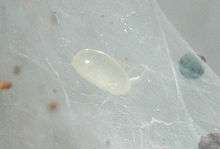
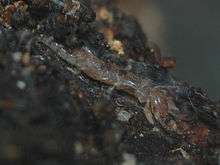
After molting, the female lays a single batch of eggs either within the existing gallery, or will find new territory to start a new colony. Here, the eggs hatch into nymphs that resemble small, wingless adults (images right and below). After a short period of parental care, the nymphs undergo hemimetabolosis (moulting into several instars before emerging as a fully grown adult after the last moult), molting a total of four times before reaching adult form. Adult males never eat, and leave the home colony almost immediately to find a female and mate. Those males that can not fly will often mate with females in nearby colonies, meaning their chosen mates are often siblings or closely related. In some species, the female will eat the male after mating, but in any event, the male will not survive for long after mating. A few species are known to be parthenogenetic, meaning they are able to produce viable offspring without fertilisation of eggs. This phemonenon occurs when a female is, for whatever reason, unable to find a male to mate with, thus giving her and her species reproductive security at all times.[11]
Behaviour and ecology
Diet
The embiopteran diet varies between species, with available food sources changing with varying habitat. The nymphs and adult females are herbivorous, feeding on leaf litter, moss, bark and lichen. As stated above, adult males do not eat at all, meaning the majority die rapidly due to depleted energy resources (starvation).
Social behaviour
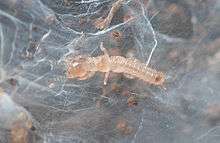
Most, if not all embiopteran species, like many other species of insect, are gregarious,[2] specifically displaying subsociality. This particular kind of social behaviour involves the female guarding her eggs and then caring for her young (right) for several days after hatching. In some species this parental care even involves the female feeding the nymphs with portions of chewed-up leaf litter and other food sources.[14]
Subsociality is a trade-off for the female, as the energy and time that is exerted into caring for her young is rewarded by giving them a much greater chance of surviving and carrying on her genetic lineage. Some species do share galleries with more than one adult, however most groups consist of one adult female and her offspring.[15]
Silk web production
Embiopterans produce a silk thread highly similar to that produced by the much better known silkworm Bombyx mori. The silk is produced in spherical secretory glands in the tarsi of the embiids enlarged forelimbs, and can be produced by both adults and larvae. Unlike Bombyx mori and other silk-producing (and spinning) members of both Lepidoptera and Hymenoptera, which only have one pair of silk glands per individual, some species of embiid are estimated to have up to 300 silk glands: 150 in each forelimb.[2] These glands are linked to 'setae-like cuticular process called a silk ejector',[16] and their exceedingly high numbers allow individuals to spin large amounts of silk very quickly, creating extensive galleries (see image below). The silk web is produced throughout all stages of the embiopteran lifespan,[12] and requires very little energy output.[17]
Galleries
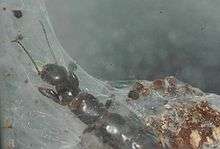
The ‘galleries' produced by embiopterans are tunnels and chambers woven from the silk they produce. These woven constructions can be found on substrates such as rocks and the bark of trees, or in leaf litter.[17] Some species camouflage their galleries by decorating the outer layers with bits of leaf litter or other materials to match their surroundings (see image). The galleries are essential to their life cycle, maintaining moisture in their environment, plus offering protection from predators and the elements while foraging, breeding and simply existing. The only occasion when an embiopteran will leave the gallery complex is when winged males fly out or wingless males walk out in search of a mate, or when females explore the area immediately surrounding them in search of a new food source.[10] On detection of a potential predator or threat, the embiids retreat into their galleries, and some species have even been observed to 'play dead' until the threat is no longer present.[18]
Webspinners continually extend their galleries into new food sources, and expand their existing galleries as they grow in size. The insects spin silk by moving their forelegs back and forth over the substrate, and rotating their bodies to create a cylindrical, silk-lined tunnel. Older galleries have multiple laminate layers of silk. Each gallery complex contains a number of individuals, often descended from a single female, and forms a complex maze-like structure, extending from a secure retreat into whatever vegetable food matter is available nearby. The size and complexity of the colony varies between species, and they can be very extensive in those species that live in hot and humid climates.[11]
Further reading
- David Grimaldi & Michael S. Engel (2005). Evolution of the Insects. Cambridge University Press. ISBN 0-521-82149-5.
- World list of extant and fossil Embiidina (California Academy of Sciences)
References
- ↑ Donald J. Borror; Charles A. Triplehorn; Norman F. Johnson (1989). An Introduction to the Study of Insects (6th ed.). Harcourt Brace College Publishers. p. 247.
- 1 2 3 4 5 Michael S. Engel & David Grimaldi (2006). "The earliest webspinners (Insecta: Embiodea)" (PDF). American Museum Novitates. 3514: 1–22. doi:10.1206/0003-0082(2006)3514[1:tewie]2.0.co;2.
- ↑ Daniel Rains Wallace (2009). "Biologist Janice Edgerly-Rooks & the Extraordinary Embiids, Silken Choreographies". Santa Clara Magazine. Spring.
- 1 2 Claudia Szumik (2008). "Phylogeny of embiopterans (Insecta)". Cladistics. 24: 993–1005. doi:10.1111/j.1096-0031.2008.00228.x.
- ↑ E. S. Ross (2000). "Contributions to the biosystematics of the insect order Embiidina. Part 1. Origin, relationships and integumental anatomy of the insect order Embiidina". Occasional Papers of the California Academy of Sciences. 149: 1–53.
- ↑ K. Yoshizawa (2007). "The Zoraptera problem: evidence for Zoraptera plus Embiodea from the wing base". Systematic Entomology. 32 (2): 197–204. doi:10.1111/j.1365-3113.2007.00379.x.
- ↑ Matthew D. Terry; Michael F. Whiting (2005). "Mantophasmatodea and phylogeny of the lower neopterous insects". Cladistics. 21 (3): 247–257. doi:10.1111/j.1096-0031.2005.00062.x.
- ↑ Romano Dallai; Ryuichiro Machida; Yoshie Jintsu; Francesco Frati; Pietro Lupetti (2007). "The sperm structure of Embioptera (Insecta) and phylogenetic considerations". Zoomorphology. 126 (1): 53–59. doi:10.1007/s00435-007-0030-8.
- 1 2 3 Ross, E. S. 2009. Embiidina. Pages 315-316 in Encyclopedia of Insects, V. H. Resh and R. T. Cardé, eds. Academic Press, New York.
- 1 2 J. S. Edgerly; J. A. Davilla; N. Schoenfeld (2002). "Silk spinning behaviour and domicile construction in webspinners". Journal of Insect Behavior. 15 (2): 219–242. doi:10.1023/A:1015437001089.
- 1 2 3 4 H. V. Hoell; J. T. Doyen; A. H. Purcell (1998). Introduction to Insect Biology and Diversity (2nd ed.). Oxford University Press. pp. 389–391. ISBN 0-19-510033-6.
- 1 2 Matthew A. Collin; Jessica E. Garb; Janice S. Edgerly; Cheryl Y. Hayashi (2008). "Characterization of silk spun by the embiopteran, Antipaluria urichi". Insect Biochemistry and Molecular Biology. 39 (2): 75–82. doi:10.1016/j.ibmb.2008.10.004. PMID 18996196.
- ↑ Arnett, Ross H., Jr. 2000. American Insects. A Handbook of the Insects of America North of Mexico: A Handbook of the Insects of America North of Mexico, Second Edition. CRC Press.
- ↑ A. D. Imms (2007) [1931]. Social Behaviour in Insects. London: Read Books. ISBN 978-1-4067-7038-4.
- ↑ Ross, E. S. 2000. EMBIA: Contributions to the biosystematics of the insect order Embiidina. Part 2: A review of the biology of Embiidina. Occasional Papers of the California Academy of Sciences 149:1-36.
- ↑ G. Alberti; V. Storch (1976). "Ultrastructural investigations on silk glands of Embioptera (Insecta)". Zoologischer Anzeiger. 197 (3–4): 179–186.
- 1 2 J. S. Edgerly; S. M. Shenoy; V. G. Werner (2006). "Relating the cost of spinning silk to the tendency to share it for three embiids with different lifestyles (Order Embiidina: Clothodidea, Notoligotomidae, and Australembiidea)". Environmental Entomology. 35 (2): 448–457. doi:10.1603/0046-225X-35.2.448.
- ↑ Romoser, William S. and J. G. Stoffolano. 1998. The Science of Entomology. WCB McGraw-Hill.
External links
| Wikimedia Commons has media related to Embioptera. |
| Wikispecies has information related to: Embiidina |
